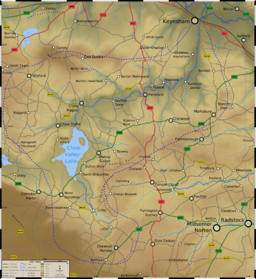River Chew
| River Chew | |
| River | |
|
River Chew between Stanton Drew and Pensford
|
|
| Country | England |
|---|---|
| County | Somerset |
| District | Chew Valley |
| Tributaries | |
| - left | Strode Brook, Winford Brook |
| Source | Chewton Mendip |
| - location | Mendip Hills, Somerset, England |
| - elevation | 305 m (1,001 ft) |
| - coordinates | 51°16′34″N 2°34′42″W / 51.27611°N 2.57833°W |
| Mouth | River Avon, Bristol |
| - location | Keynsham, Somerset, England |
| - elevation | 10 m (33 ft) |
| - coordinates | 51°25′29″N 2°30′26″W / 51.42472°N 2.50722°WCoordinates: 51°25′29″N 2°30′26″W / 51.42472°N 2.50722°W |
| Length | 27 km (17 mi) |
| Basin | 145 km2 (56 sq mi) |
| Discharge | for Keynsham |
| - average | 1.18 m3/s (42 cu ft/s) |
| - max | 20 m3/s (706 cu ft/s) |
| - min | 0.5 m3/s (18 cu ft/s) |
|
Topographical map of the Chew Valley
|
|
The River Chew is a small river in England. It merges with the River Avon after 17 miles (27 km) forming the Chew Valley.
The spring from which the Chew rises is just upstream from Chewton Mendip. The river flows North West from Chewton Mendip through Litton, Chew Valley Lake, Chew Stoke, Chew Magna and Stanton Drew. The river passes under the A37 at Pensford almost making the old church and pub garden into an island. The river then flows through the villages of Publow, Woollard, Compton Dando and Chewton Keynsham before joining the River Avon at Keynsham. For much of the Chew's route the Two Rivers Way footpath is alongside, the same route for part of its length is also part of the Monarch's Way long distance footpath. In total the Chew flows for some 17 miles (27 km) through the North Somerset countryside.
The name "Chew" has Celtic origins, cognate with the River Chwefru, cliwyf-ffrenwy, "the moving, gushing water", ancient forms are Estoca (Chew Stoke), Chiu (Chew Magna) and Ciwetune (Chewton Mendip). Its exact meaning has suggested several other explanations, including "winding water", the ew being a variant of the French eau, meaning "water". The word chewer is a western dialect for a narrow passage and chare is Old English for turning.
However, some people agree with Ekwall's interpretation that it is derived from the Welsh cyw meaning "the young of an animal, or chicken", so that Afon Cyw would have been "the river of the chickens".
...
Wikipedia


